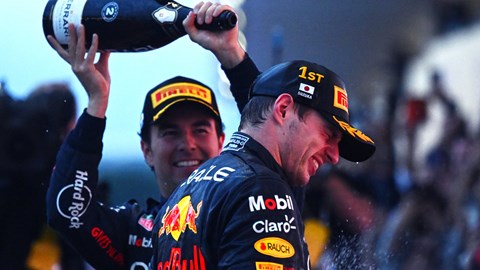The Formula One circus returned to Suzuka this weekend, and in many ways the race was a disappointment. In others, it most typified the 2022 championship, which is sort of the same thing. It had a good dose of everything we’ve seen from F1 this year; inconsistencies, confusion, and a good helping Ferrari mistakes to top things off. But there was even some good racing in there for around forty minutes or so, too.
Ultimately, the history books will record this as a full race in which Max Verstappen won his 2022 Driver’s championship. So what actually happened in the Japanese GP? Keep reading for 6 things we learnt from Suzuka this year.
1. Wet tyres don’t really get used
Formula One frames itself as a sport that can race in the wet and the dry – and it even supplies three tyres to show off the fact; slicks, inters and wets. However, for the last few years fans and drivers have asked if F1 really can be run in the wet. After a Singapore GP that was delayed due to wet weather, we had the same happen in Suzuka this week. And when the race finally got underway the second time, many drivers claimed it was almost time for inters already – so why even have a wet tyre, or delay things for so long?

2. Sainz puts it in the wall
When the race finally did get going, the conditions weren’t ideal – but every single top driver managed to make it around; apart from Ferrari’s Carlos Sainz. No more than halfway around the lap, the Spaniard managed to lose control of his Ferrari. Although Sainz has shown flashes of pace this year, this has been a season to forget: errors like these have taken him out of championship contention just as much as the mechanical failures.
What’s more, they have also damaged both of the Scuderia’s title challenges: this race saw pressure from the second Red Bull push Leclerc into a mistake, with Sainz unable to help. It’s not the first time this has happened.
3. Safety procedures
2014 was the last time an F1 driver died from injuries sustained in a race, and it happened at Suzuka in wet conditions. Jules Bianchi hit a recovery vehicle in treacherous conditions, and the incident prompted a rethink of safety car procedures – as well as the introduction of the halo.
Fast-forward 8 years, and it seems as though both the FIA and the Suzuka track had learnt none of the lessons from 2014. After Sainz’s incident, a recovery vehicle was deployed onto the track, with drivers whizzing past at high speeds. In many ways, this was even riskier than what happened in 2014.
Pierre Gasly was racing at full speed after pitlane start came across the vehicle just half a second before his steering wheel notified red flag conditions. The FIA later penalized him for his driving after the incident, but it was a shocking case of ‘whataboutery’ in response to an incident that could’ve very easily caused a fatality.
‘What is this tractor on track’ said Gasly on team radio. ‘I passed next to it. This is unacceptable. Remember what has happened. Can’t believe this.’
“Obviously I got scared,’ he said after the race. ‘Obviously if I would have lost the car in a similar way Carlos lost it the lap before… I would have died, as simple as that.’
4. Mercedes race win might not happen this year
Mercedes can no longer defend its constructor’s championship, meaning the record will now freeze at eight consecutive titles in a row. Lewis Hamilton’s record of a win every season is also now in doubt, as just four races remain this year – and the W13 hasn’t looked like a contender since Zandvoort.
The W13 had good pace on Friday, but the race revealed a lack of straight-line speed – and that ultimately decided Hamilton’s position. For almost the entire race, Hamilton battled with the Alpine of Ocon. And although the British driver got good exits from the chicane and hairpin, a lack of DRS (not used in the wet weather) and top speed meant he couldn’t really make an impact.
5. Vettel delivers at his last Suzuka
Suzuka has always been one of Sebastian Vettel’s favourite circuits, and he showed everyone by pulling off arguably his best weekend this year. After qualifying 9th, Vettel pipped the Alpine of Fernando Alonso to 6th place on Sunday – beating the Spaniard by just 0.011 of a second at the line.
6. Max Verstappen wins the title in dubious circumstances
Verstappen’s second title, like his first, was decided in the steward’s room. However, rather than an extremely questionable decision after a competitive season, this time it was thanks to speedy swift five second penalty and a rule which meant full points were awarded, despite not doing a full race distance.
Ultimately the season was so one-sided so there was no real controversy – it was partly decided by yet another Ferrari mistake – but it was an anti-climax. It seemed only the FIA seemed to know how to interpret the rules this time, as both Verstappen and his team were unaware he’d won the title too.
What should’ve been a fairytale win at the heavily-branded Honda track was just another mire of rule interpretations and inconsistencies. Throw in new, shocking budget-cap findings and now his first championship is under scrutiny again, too.